Family : Felidae

Text © DrSc Giuliano Russini – Biologist Zoologist

English translation by Mario Beltramini
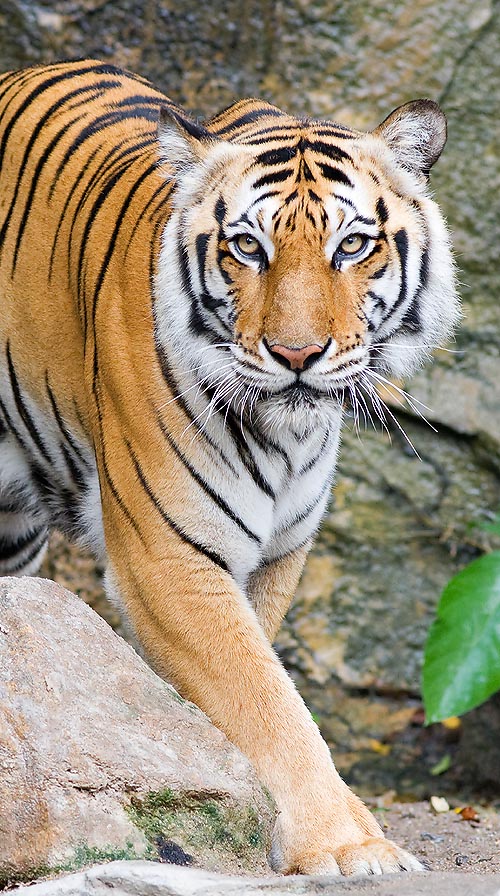
With less than 2000 individuals free, the Bengal tiger is endangered © Giuseppe Mazza
Probably, the African lion presents phenomena of aggressiveness which, contrary to what is thought render it more dangerous in the wild than the tiger and more difficult to manage in captivity, as observed by the zoological biologists.
Also the dimensions which, in an almost legendary way are often rendered in favour of the tiger, in reality have true and proper equivalences. On the contrary, the tiger has an inferior muscular mass compared to the African lion and a greater adipose panniculus. This caused by overheating corporeal overheating phenomena, is in fact a handicap in case of prolonged fights, drawback not found in the lion who, as they say, “will struggle up to the death”.
Same can be said for the fighting techniques, which all stand in favour of the Panthera leo, accustomed, as it is, to face in the savannah a great variety of preys and competitors, in comparison with the solitary tiger, which, but the Leopard (Panthera pardus) along with the black panther, its melanic form, the Dhole (Cuon alpinus), some gavial or crocodile and possible pythons, has quite a few animals with which to struggle in its own biotope (see texts Felidae and Panthera leo).
The Asian elephant (Elephas maximus) excepting the young and some sick and very old specimen, is the only species the tiger avoids to attack, seen its mass; in fact, in India, Sri Lanka and in other Indochinese areas, often the natives utilize this colossus for carrying weights in long convoys or for transporting the tourists, sure, as they are, that the tiger does not attack in their presence. Even if equipped with guns, the elephant is in fact the best deterrent, as the tiger is unforeseeable and strikes deadly suddenly: the “somatolysis” properties of its coat render it in fact almost invisible in the forest and in the humid zones with thickets of reeds, not to talk about its soundless movements.
Also the Asian rhinos may be a tough customer for this feline, but without forgetting that when a tiger is hungry, nervous of it is a mother noticing its cubs in danger, it will not hesitate to attack them, because, like the lions, they are very courageous animals. And like the existing so-called solitary, man-eating, lions, also the tiger may do the same. Especially in the past, numerous were the cases of murderous attacks carried in Asia by these felines, especially in proximity of villages, against men and kids. It is necessary to add, however, that, as often happens, that these are negatively amplified by the local populations, by means of tales and legends.
This is the opinion of the English zoological biologist DrSc George Schaller, who for 40 years has studied these animals in the wild, who, on the contrary, thinks about the occurrence of a form of ethological co-evolution, a sort of “spontaneous taming” between this feline and the human being, much stronger than in the lions. Unless hungry, scared or annoyed, the tigers have, in a word, learnt to avoid the man, whereas the lions remain more aggressive. But this is not sufficient for balancing the bad reputation of exaggerated tales which have marked this poor animal, subject in the past, of real slaughters done by hunters, so much to place it among the most endangered animals, as the IUCN has declared from the seventies of the last century, inserting it in the “Red list of endangered species”.
It is not well clear, nowadays, how many tigers (all the various known species and subspecies are under census by the zoological biologists and rangers with programmes of the Taxon Advisory Group “TAG”) are still alive and free in the wild, but it is thought that “unfortunately”, they do not over come the 2.000, and this is already, maybe, an optimistic estimation!
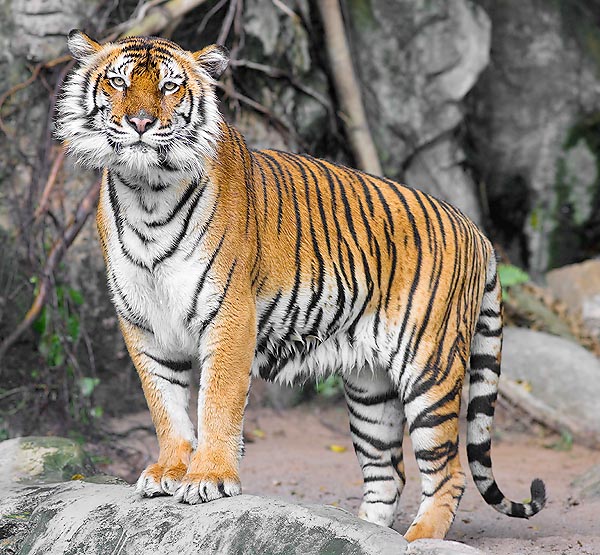
In the wild it fears only elephants and flocks of wolves, but the true foe is the man © Giuseppe Mazza
This applies to the Indian species (Panthera tigris), to the Siberian subspecies (Panthera tigris longipilis, by other authors called Panthera tigris altaica Temminck, 1844) as well as to the white coated hybrids, that is the greatest n the group, the Java and Sumatra subspecies (Panthera tigris sondaica), and the Bengal one (Panthera tigris tigris) which, with the Siberian, is maybe the most endangered.
The Siberian tiger (Panthera tigris longipilis or altaica) for adapting to the rigid climates of Siberia and Mongolia, has developped an ecological adaptation a much longer coat than in the other species or subspecies; occasionally phenomes of hybridization of the Siberian species with other species or subspecies or of genetic drift, generate a white colouring of the coat, which camouflages it perfectly with the snow. Among all tigers, both species and races, it is the biggest, but nowadays is also standing among those with the highest risk of extinction.
In some areas such as southern China, south-eastern Asia, Pakistan, Iran, Iraq, where some subspecies did live till the fifties of the last century, the tigers have been now almost or totally exterminated by the man, due to the hunting game, the look for trophies, or for furnishing organs (teeth, liver, gall-bladder, eyes) to the Chinese medicine, taking advantage from the stupid belief that these organs had medicinal or even aphrodisiac properties, not to forget the phenomena of poaching connected with the teeth and the furs to be commercialized abroad. And, should not be this enough, the human being is destroying the biotopes where the few extant populations live.
Before describing the zoogeography, the ecology-habitat, the morpho-physiology, and the reproductive biology, ethology and ecology of this splendid carnivore of the family of the Felidae, I would like to spend a word about the relationship the tiger has had in the history with the man. The tiger remained for long time unknown to the western civilizations. The first alive tigers, possibly Persian, came in Europe only during the late Roam Empire. On the contrary, as logic, this feline occupied a top-notch position in the legends and in the mythology of the eastern populations, who saw in it the symbol of the strength and of the wildness. The tiger was worshipped by the north-eastern Asia peoples, even if then, in reality, it was fought with fury by the man; and this has happened also in India, where usually the respect for the animals is very high, compared with the rest of the world.
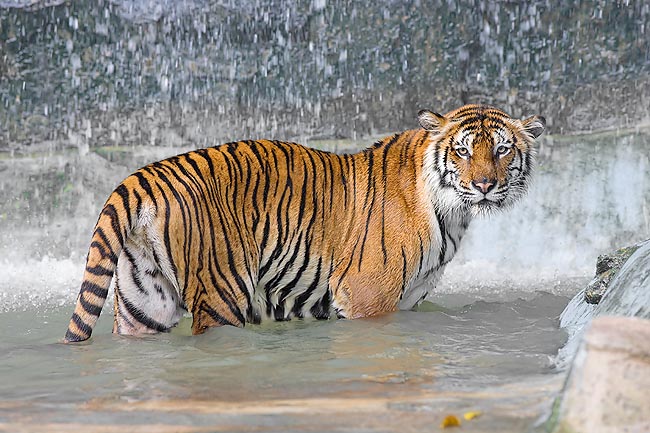
Unlike cats, the tiger loves water and surprises the victims while they are watering © Giuseppe Mazza
Unlike the old or sick lions, too slow for seizing fast ungulates, in reality the anthropophagy is not a common practice in the tigers: those who were attacking and still attack it’s only because the villages were created too much in proximity of the jungle, in their hunting territory.
In their natural biotope, the tropical jungle, thick and impenetrable, or the humid zones with thickets of cane where they perfectly camouflage, the tigers in fact have been able to develop a hunting technique quite different from the other felines, a sort of guerrilla, a hit and run based on ambushes, at the expenses, sometimes, of the human beings.
The hunting of the tiger is usually done by means of traps, where the animal is attracted with living bait, for instance a goat or a sheep tied to a stake, while the hunters stay over a platform at 10-12 from the ground ready to shoot. But it may be also a system with a cage. The tiger is attracted by means of the alive animal, placed inside as bait, and when entering the cage, it touches some device which shuts immediately the door behind the prey.
The free gaming especially practiced in the past till the beginning of the XX century by the Indian, Chinese nobles and by the English settlers, was done, on the contrary, for avoiding risks, utilizing a high number of persons. A ludic activity, like that which, at the time and still now, is unluckily done by the English nobles against the poor Red fox (Vulpes vulpes).
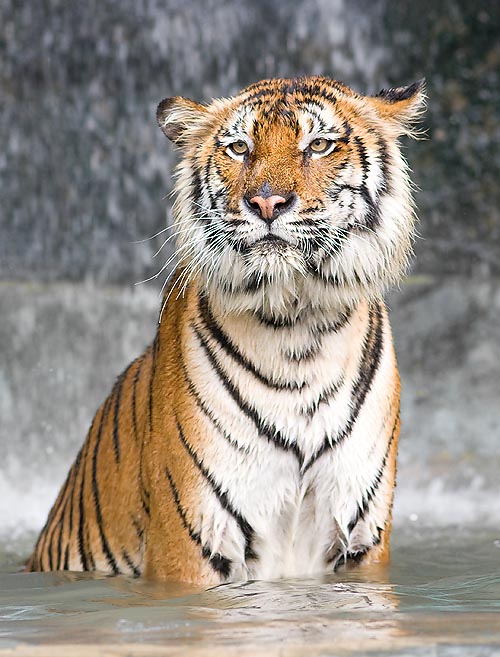
Preferred preys are boars, antilopes, deer and water buffaloes © Giuseppe Mazza
Zoogeography
In the past, the Panthera tigris had a range extending with the various characterizing it, from Russia – Siberia, to India, Java, Sumatra, up to southern China, in Persia (Iran), and Mesopotamia (Iraq), with specimens (subspecies) which might go around also in Asia Minor and Turkey.
Nowadays, it is found, with much reduced populations, in India, southern China (but where, perhaps, it is already extinct), Siberia, Mongolia, Manchuria, Bengal, Indochina, Sunda Islands (Sumatra, Java), and North and South Korea. And, as already said, the Siberian and the Bengal tigers are the two most endangered species.
Morpho-physiology
The tiger is, along with the lion, the biggest mammiferous, eutherian-placentate carnivore, being both over come only by the bear.
It has an elegant livery with black bands, on reddish-yellow coat, which allows the animal to disguise in its biotope, exploiting the phenomenon of the “somatolysis”, the coat of the animal is, in short, absorbed by the chromatism and by the light effects of the environment, which hinders, when the animal is still, the discrimination of the outline.
And also in the case of the Siberian tiger (Panthera tigris longipilis), the white coat adapts perfectly to the snow, considering that in Siberia and in Mongolia, where it lives, the winters are, without fail, long and snow-clad. The very short summer lasts, at the most, one month and a half, and therefore it is a classical eco-evolutionary adaptation. This powerful animal may reach, in the biggest specimens like the Siberian tigers, the 3,5 m of length, where, however, one metre belongs to the tail. The height at the withers may reach the 120 cm, and the weight is more than 300 kg. The smallest subspecies is the Bengal (Panthera tigris tigris), probably because always living in the thicket of the jungle, in limited spaces, whilst the Indian moves in ampler areas, in the humid beds of reeds zones, and the Siberian in the huge snow-clad glades.
The tiger has a slim silhouette, with a trunk strongly compressed on the sides, and with an almost constant height for the relevant species or subspecies. The shoulders have, however, a pronounced gibbosity.Compared to the lion, it has a more roundish and less bulky body, with slimmer paws which guarantee the animal longer jumps and more ability when climbing trees.

It doesn't disdain fishes and is an excellent swimmer © Giuseppe Mazza
It has a robust tail, ending in a tuft, and furthermore, has a powerful mane defending it during the fights, of a much paler colour and less voluminous in the young individuals, and then remarkably darkens to a burnt-brown colour in the sexually mature specimens, due to endocrinous and environmental reasons, as already discussed in the text of the Felidae. In the tiger, the tuft on the tail and the thick mane, already anyway much reduced in the Indian lion, are both missing. The mane has practically disappeared excepting a trace in the zone included between the ears and on the sides of the throat, apart some subspecies, like the Bengal, where we can talk of a mane, obviously much modest in comparison with the African lion. But what attracts immediately the attention, is the remarkable difference in the livery. That of the tiger is much more complicated. It has a background tint going from whitish to reddish-brown, but, in most cases, it is yellowish brown, darker on the back and paler on the sides, whilst the inferior parts, belly and throat, are white.
On this over pose irregular blackish bands which, starting from the back, run along the sides, slightly backwards. Other black bands, less numerous and detached from the above, run transversally the belly, and others more, the hind limbs and the tail, whereas the forelimbs usually do not have bands on the outer side. The background tint is present on the snout, limited only to the front -in the >Bengal toger it is darker), the nasal septum and the zygomata. The eyebrow arch, the cheeks, the lips and the chin are white. The black stripes of the snout are rather irregular, placed approximately in way to frame the face. The “rhinarium” (the apical, glabrous part of the nose), is red. The ears are white (obviously for the Siberian the coat is all pale white, with the ears edged of white as a continuation of the irregular black bands), on the inner surface, and the zoological biologists think that this difference of colour is useful as “optical signal” for the other members of the same species.
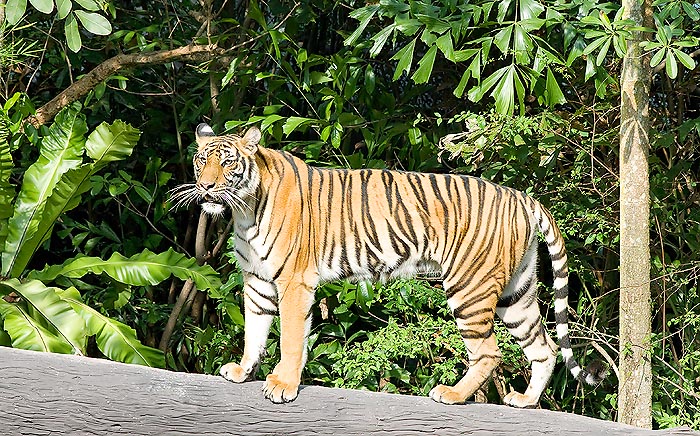
The black striped livery disguises it perfectly among the jungle light-shades or the reeds © Giuseppe Mazza
When, on the contrary, the tiger remains on the defensive, it will snarl keeping the ears lowered.
Vice versa, some English zoological biologists seem to have proved that in the lions, the lowered ears are a signal (in the males as well as in the females) of determination to attack and hit.
About the white tigers found in the various zoo-parks, we have to say that they are not albinos, and not even, like the lions, leucistic white, as we have treated in the introduction to the Felidae.
The popularly called albino tiger is a typical instance of genetic pollution: of hybrids having a pool of genes coming for the 90% from the Siberian tiger and for the 10% from the Bengal one, in consequence of mistaken crossings effected in captivity during the seventies. These tigers have, in fact, a big head and white coat as the Siberian, but the length of the hair and the overall dimensions of these animals are those of the Bengal subspecies.
Therefore, we are not facing a new subspecies and not even a recessive phenotypic mutation (typical of the albinism), but a hybrid created erroneously and unwarily freed in the wild in the Bengal region, against the will of the conservationist biologists of the relevant natural parks in situ, which has weakened the pure blood line of the Bengal race, contributing and accelerating the extinction process.
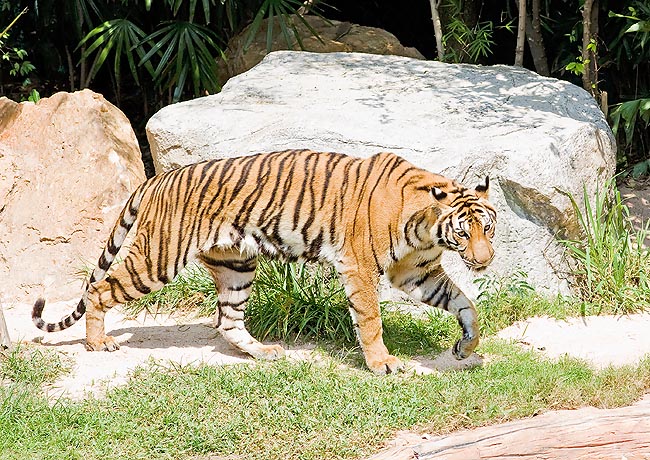
When a tiger turns the ears showing the white dots, it’s a sign of attack © Giuseppe Mazza
Ethology-Reproductive Biology
The tigers, unlike the lions which have their own harem, are solitary animals. They get together in couples only for short periods, during the courting and coupling phases.
It seems that, at least in the warm regions, there is not a well defined, and marked by the season, period of the mating, as on the contrary, happens in the regions of the temperate zone, seen that the cubs come to life in all months of the year.
The gestation lasts about three months and a half, and the cubs come to life in number of 1 to 5 per each delivery.
But when the litter is too abundant, the mother, unable to attend more than two or three tiger cubs at the same time, is obliged, alas, to eat the exceeding progeny!
Cubs are nursed along their first, or first and a half, month of life then the mother weans them, and begins to nourish them with flesh of killed preys.
When they are about two months old, the cubs follow their mother during the beating, without anyway taking any active role. And it is only after some months that the female knocks down its own prey, but doesn’t kill it, leaving this task to the cubs in order that they may learn. When about one year old, the young tigers are independent enough and leave their mother, for beginning their solitary life.
As we have seen in the treatise of the felines, each tiger takes possession of a hunting territory of about 10 square kilometres as an average. In order to inform the other tigers of its presence and dominion, it marks the limits with smelling traces, usually urine, and with visual and acoustic signals, such as scratched trunks and roars. These signals are usually sufficient for keeping away conspecific strangers, whose presence is anyway tolerated for short periods.
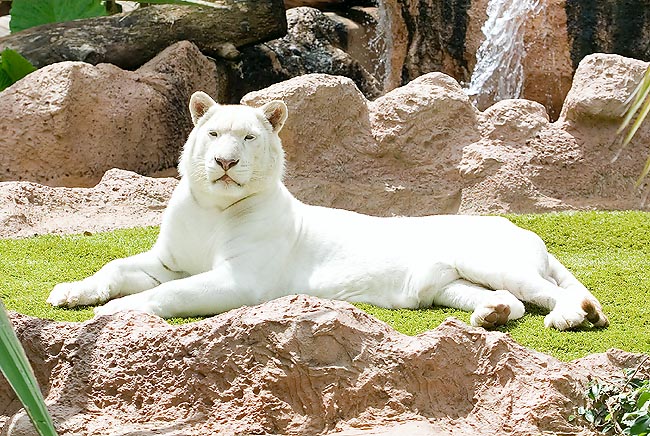
The white tigers of the zoo-parks are not albino, but hybrids of the Siberian tiger with the Bengal one © G. Mazza
We have to bear in mind, furthermore, that even if a solitary animal, the tiger anyway is not much aggressive towards its conspecifics, even if they very rarely share a meal.
Contrary to the African lion, king of the open spaces of the savannahs, the tiger prefers as abode the tangle of the tropical and humid zones thickets, habitats where its showy livery is able to perfectly disguise its mighty structure. Despite this, it does not draw back from the areas inhabited by humans, or built by them, provided it likes them.
In India, as emplacement for their operations, they chose the ruins of some temples, where they spend dozing the diurnal and warm hours, whilst they are much more active during the night or by dawn.
As a matter of fact, the hunting activity of the tiger develops during the night or by the first morning hours.
Helped by its eyesight and smell, fairly keen, and by the very good sense of smelling, it silently lies in ambush by the ponds, where, by that time, the herbivores co for quenching, ready to dash on the selected preys. Among the preferred victims, stand board, wild pigs, the Blackbuck (Antilope cervicapra), the deer and the huge Nilgai (Boselaphus tragocamelus). Only the the strongest individuals attack also the Water buffaloes (Bubalo bubalis).
During the hunting, the action of the tiger is less powerful than that of the lion. Whilst this last one, after having jumped over the biggest preys, kills them while running, breaking their spine with a deadly paw, the tiger, unable to perform such exploit, kills them on the ground by breaking with a bite the cervical vertebrae to the smallest preys and choking the big ones, landed by the impact with the forelimbs, with a prolonged bite to the throat which constraints the jugulars. Once its own prey is killed, the tiger doesn’t eat it on the spot, but drags it in the thicket of the bush, in order to consume it undisturbed.
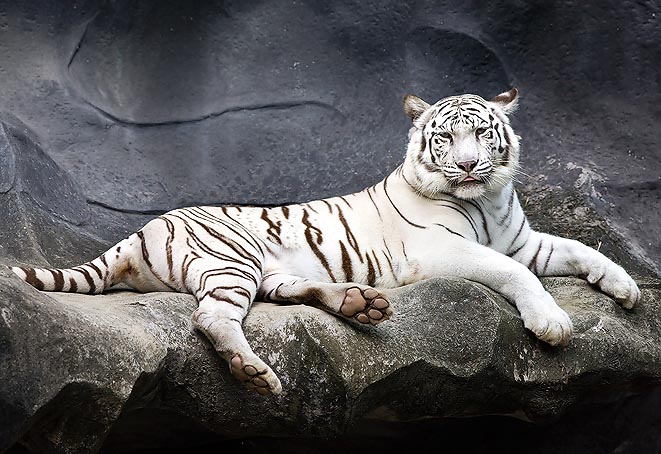
Also this white striped tiger, with the Siberian’s skull, is a clear genetic drift © Giuseppe Mazza
It seems that during one single meal, a tiger is capable to gobble about 20 kg of meat! What remains, well hidden, if not robbed by the Leopards (Panthera pardus), will be eaten later on.
As briefly said before, the tiger avoids carefully the Asiatic elephants, nowadays anyway very rare in the wild, and the rhinos, and does not interfere with the predatory activity of the other Asiatic carnivore, the leopard.
In any case a fearsome foe for the Indian tigers is the Red wolf, called also Dhole (Cuon alpinus), which wanders in aggressive and large flocks with 20 and even more individuals.
When they attack a robust tiger this one may, at the most, kill 6-7 of them, and has few hopes of salvation if it does not run away.
The Siberian tiger (Panthera tigris longipilis), in order to adapt to the rigid climates of Siberia and Mongolia, has developed as ecological adaptation a much longer coat, white coloured, which disguises it in the snow. It is bigger than the southern tigers, but stands among the most endangered ones.
The Bengal tiger (Panthera tigris tigris) is present also in Indochina and in southern China, but is absent in Sri Lanka. And, despite this vast distribution range, is, also this one, strongly endangered. Lastly, the Java tiger (Panthera tigris sondaica), is limited to Sumatra and Java. Whilst endangered in the island of Java, highly populated by men, in Sumatra, poorly inhabited compared to its surface, (there are there mainly tribal populations living in rural villages), its is still fairly abundant and more common than in the continent.
Other much rare subspecies of tigers are the Korean tiger (Panthera tigris coreenensis), spread from Mongolia to Korea, and the Caspian tiger (Panthera tigris virgata), nowadays almost extinct and typical of Iran.
